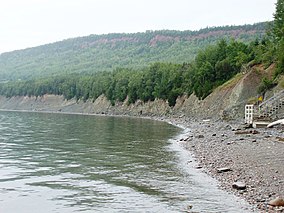Miguasha, Quebec
| Parc national de Miguasha | |
|---|---|
|
IUCN category III (natural monument or feature)
|
|

Cliff of the Miguasha National Park
|
|
| Location | Nouvelle, Avignon Regional County Municipality, Quebec, Canada |
| Nearest city | Dalhousie, New Brunswick |
| Coordinates | 48°06′38″N 66°22′10″W / 48.11056°N 66.36944°WCoordinates: 48°06′38″N 66°22′10″W / 48.11056°N 66.36944°W |
| Area | 87,3 ha |
| Established | 6 February 1985 |
| Governing body | SEPAQ |
| Type | Natural |
| Criteria | viii |
| Designated | 1999 (23rd session) |
| Reference no. | 686 |
| State Party |
|
| Region | Europe and North America |
Miguasha National Park (French: Parc national de Miguasha) is a protected area near Carleton-sur-Mer on the Gaspé Peninsula of Quebec in Canada. Created in 1985 by the Government of Quebec, Miguasha was designated a World Heritage Site in 1999 in recognition of its wealth of fossils, which display a crucial time during the evolution of life on Earth. Other names for this site are the Miguasha Fossil Site, the Bay of Escuminac Fossil Site, the Upper Devonian Escuminac Formation, and the Hugh-Miller Cliffs. It is also sometimes referred to on fossil specimens as 'Scaumenac Bay' or 'Scaumenac Bay P.Q.'
The park's museum features exhibits about the fossils and paleontology of the park. The museum's collection includes over 9000 specimens of fossil fish and plants.
The coastal cliffs are Upper Devonian strata of grey sedimentary rock. They are composed of alternating layers of sandstone and shale, which are 350–375 million years old. The area today supports mainly birch, aspen, and fir forests.
Some of the fish, fauna, and spore fossils found at Miguasha are rare and ancient species. For example, Spermasposita is thought to be one of the oldest flowering plantgenera on Earth.
Miguasha National Park is considered to be the world's greatest palaeontological record of fossils from the Devonian Period, known as the 'Age of Fishes'. Five of the six main fossil fish groups from this period (dating from 370 million years ago) can be found here. A great quantity of some of the best-preserved fossil specimens of lobe-finned fish, ancestors to the tetrapods (believed to be the first four-legged air-breathing terrestrial vertebrates), were found here.
...
Wikipedia

